Illinois Auto Accident Statistics
Every day, the streets of Illinois are filled with traffic as people head to work, school, and other activities, unaware that a dangerous crash could be just around the corner. The sheer volume of daily commuters inevitably leads to accidents—some minor, others life-altering. Looking at Illinois auto accident statistics can make you more aware of the risks of sharing the road and empower you to take proactive steps to avoid them.

- Understanding Illinois Auto Accident Statistics
- Total Number of Auto Accidents in Illinois by Year
- Common Causes of Auto Accidents in Illinois
- Auto Accident Fatalities in Illinois From 2020 to 2025
- Accident Statistics by Region in Illinois
- Levin & Perconti: Your Trusted Partner in Illinois Auto Accident Cases
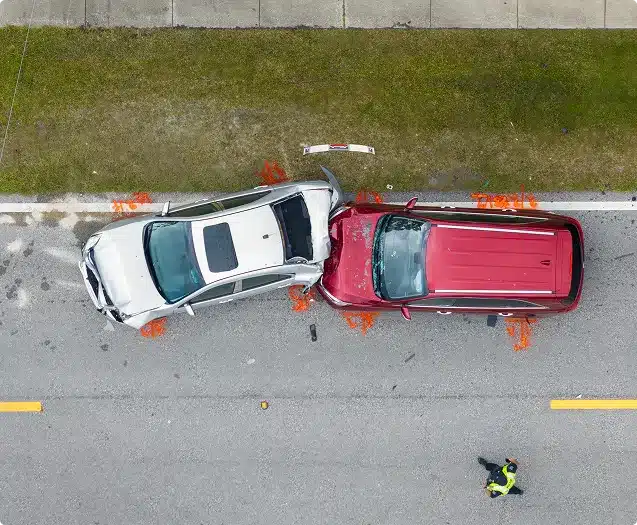
Understanding Illinois Auto Accident Statistics
When reviewing Illinois car crash data, every type of incident is important to fully understand driving hazards. Even a seemingly minor incident can cause lasting damage, such as whiplash, broken bones, and spinal cord injuries. Understanding why and how often accidents occur can help protect yourself and others from all kinds of accidents, from fender-benders to rollovers to catastrophic, fatal collisions.
Illinois’ Department of Transportation, or IDOT, compiles auto accident data for all types of crashes each year. This information is a valuable resource for everyone, including individuals proposing public safety initiatives, law enforcement officers, and drivers of all kinds of vehicles. It provides insights into the most common kinds of car accidents and what people can do to prevent them, whether recommending your city install a new traffic signal or taking a class to improve driving skills.
Total Number of Auto Accidents in Illinois by Year
Every year, thousands of people get into auto accidents in Illinois. IDOT collects information about all these incidents and releases it to the public each year. This data provides a detailed look at total motor vehicle crashes and Illinois traffic fatalities by year.
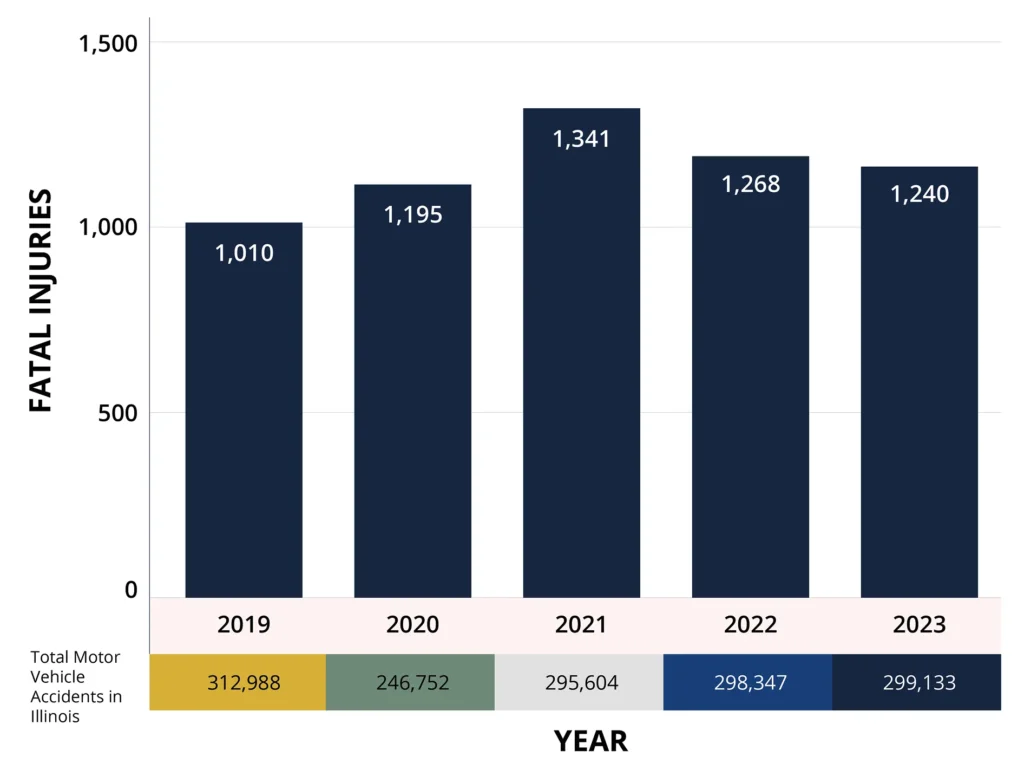
These statistics show a dramatic decrease in crashes from 2019 to 2020, which most likely occurred because more people stayed home during the COVID-19 pandemic. Unfortunately, these numbers are shifting back upward as people have returned to their pre-pandemic commuting habits. The number of deaths has also risen, underscoring the need for drivers to exercise greater caution when they’re on the road.
Common Causes of Auto Accidents in Illinois
Motor vehicle accidents happen for a wide range of reasons, but a few key factors are involved in the majority of crashes in Illinois. Recent data, including information from IDOT, highlights these as the most common causes of car accidents in the state:
- Speeding: Driving too fast can increase the risk of a crash by reducing your reaction time and making it difficult to stop before striking a vehicle, object, or pedestrian. High-speed collisions are also more severe due to the greater force involved, with nearly half of Illinois' fatal crashes in 2023 involving speeding.
- Distracted driving: Talking on the phone and texting while driving are well-known causes of accidents, but any type of activity that takes your attention from your driving, current road conditions, and other cars around you can lead to a potentially harmful crash.
- Driving under the influence: Alcohol and drugs, which impair a driver's judgment and coordination, are among the most frequent causes of car accidents, and over 22% of fatal crashes in Illinois in 2023 involved alcohol.
- Following too closely or tailgating: Driving without enough distance between you and the vehicle in front of you can lead to rear-end collisions. Rear-end collisions made up almost 25% of injury-causing crashes in Illinois in 2023.
- Improper lane usage: Accidents also occur when people break traffic laws for multi-lane roads, such as weaving through traffic, failing to signal, making sudden or aggressive lane changes, or neglecting to check their blind spots.
- Failure to yield: Drivers sometimes collide with other vehicles or pedestrians and cause accidents in Illinois if they disregard the right-of-way at intersections, don't stop at a red light, or ignore yield signs and crosswalks.
Fortunately, many of these common causes are preventable if you use safe driving habits. For example, you can prevent drinking and driving accidents by planning ahead, asking someone to drive you home, or using a ride-share or taxi service.
In hit-and-run accidents and other types of incidents where other drivers are at fault, you may have little or no control over the events leading to the accident, but staying alert and focused on the vehicles around you can help keep you safer.
Auto Accident Fatalities in Illinois From 2020 to 2025
Any fatal car accidents Illinois experiences are a tragedy, but the state has seen some progress in reducing deadly crashes over the past year. According to the data available in June 2025, the state reported 455 fatal accidents resulting in 500 fatalities, down from 548 fatalities at the same point in 2024. Of those deaths, 93 were pedestrians and 43 were motorcyclists, and the vast majority occurred on U.S.-state routes or city streets.
Although the numbers were different, these trends have remained. For example, the state had 1,196 traffic fatalities in 2024, and 217 of those were pedestrians, who are especially vulnerable because of their lack of protective equipment or gear when facing an oncoming vehicle. Illinois has experienced more than 1,200 auto accident fatalities annually since 2020, and more than half of them occurred on U.S.-state routes or city streets each year. This date contradicts the frequent assumption that interstates are more dangerous than streets with lower speed limits.
Accident Statistics by Region in Illinois
Although Illinois as a whole has seen a rise in traffic accidents in the past few years, the numbers differ significantly by region. Areas with higher population densities and more complicated or confusing traffic patterns generally see worse crash rates than rural roads, but that doesn’t mean accidents only happen in places with heavy traffic.
These are the most recent statistics for parts of the state, including rural areas, where accidents and fatalities are more likely to occur:
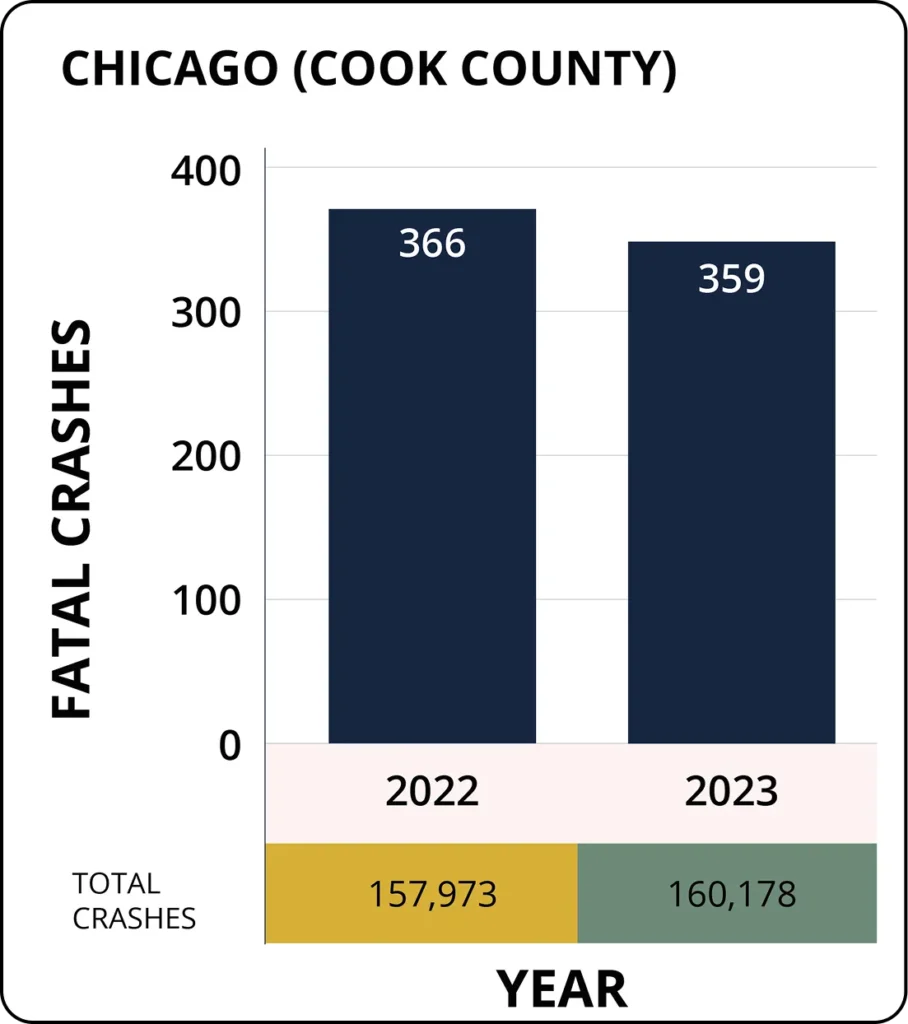
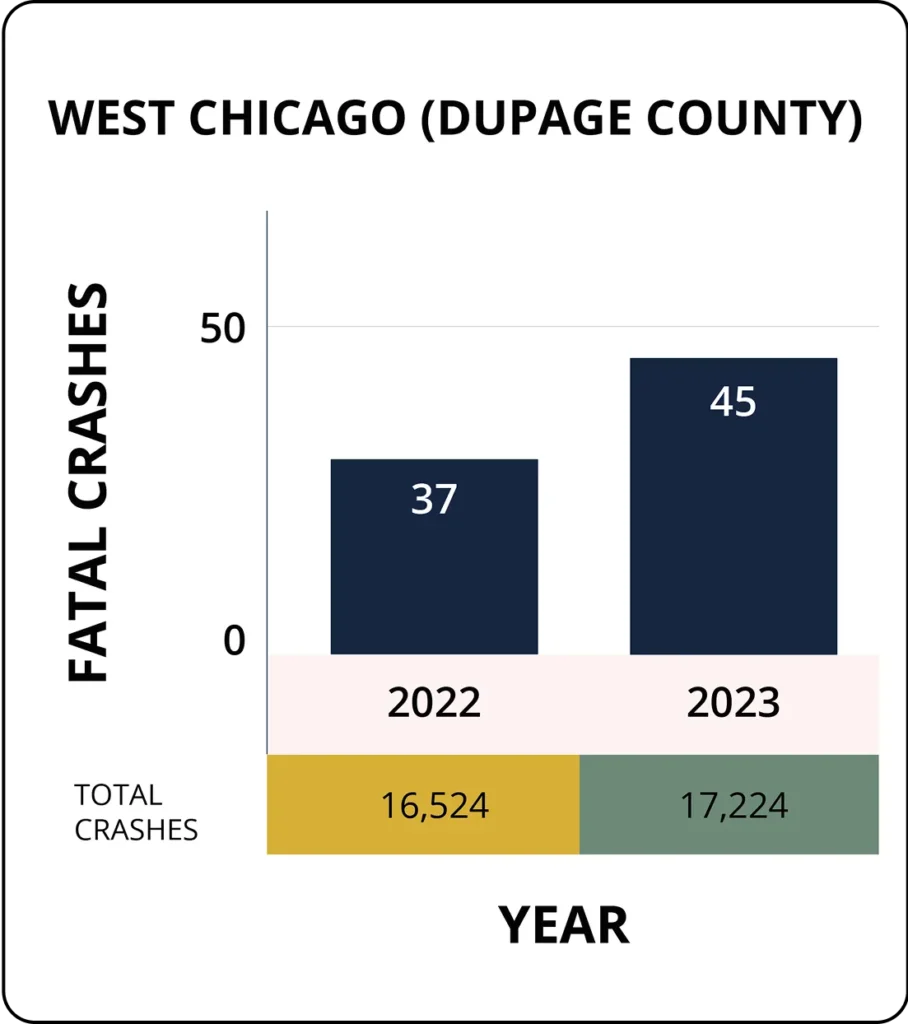
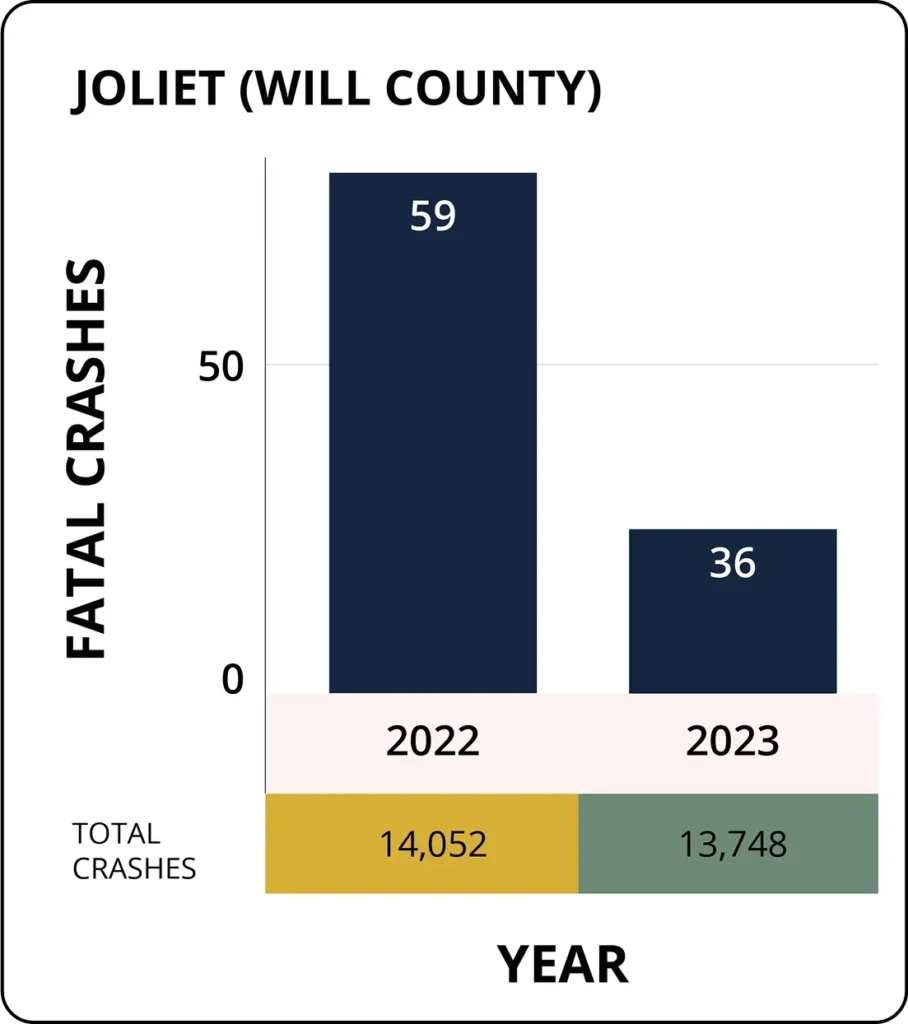
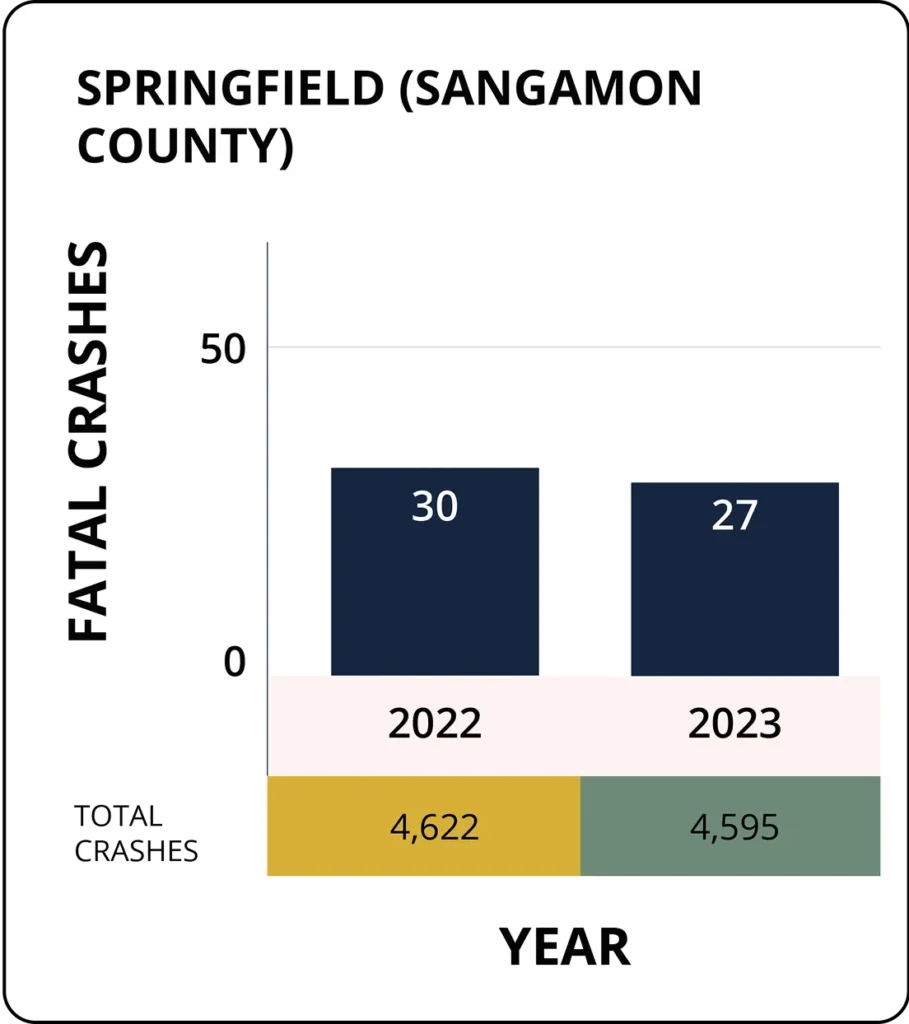

- Chicago (Cook County): As the state’s largest metropolitan area, Chicago and Cook County consistently have the highest volume of motor vehicle accidents. In 2023, the region had 359 fatal crashes and 160,178 total crashes, more than half the accidents for the state that year. In 2022, it had 157,973 accidents, of which 366 were fatal.
- West Chicago (DuPage County): The second-most populous county in the state, DuPage County, had 17,224 crashes, 45 of which were fatal, in 2023. Unlike some other areas with high crash rates, this represents an increase from 2022, when it experienced around 700 fewer accidents and eight fewer fatal crashes.
- Joliet (Will County): Although its population is smaller than DuPage County’s, Will County’s accident rate is still concerning, with 13,748 crashes, 36 fatal, in 2023. However, this number is a slight improvement over 2022, when they had 14,052 accidents, 59 fatal accidents.
- Springfield (Sangamon County): In 2023, 4,595 car accidents resulting in 27 deaths occurred in Sangamon County, which has a population of around 194,000 people. Although the number of accidents increased from 2022, which had 4,622 crashes, the number of fatal accidents decreased from 30 in 2022..
- Other notable regions: While Henderson County only had 196 total and three fatal crashes in 2023, it has a high accident rate considering its population of just over 6,000 people. Schuyler County is another rural area with frequent accidents, totaling 229 in 2023, but there were no fatalities.
Paying close attention to your surroundings and carefully following traffic laws is especially important in areas where roads are often congested, such as Chicago and West Chicago. However, information from less populated areas shows that accidents can happen anywhere. Driving cautiously is the best practice whether you’re on a back road in the country or a crowded city street.
Levin & Perconti: Your Trusted Partner in Illinois Auto Accident Cases
Suffering an injury or losing a loved one in a car crash can take a financial, physical, and emotional toll, and a knowledgeable attorney can help you navigate the legal system and recover compensation. You can file a claim for damages to cover medical bills, funeral expenses, and lost wages. The attorneys at Levin & Perconti have extensive experience representing victims of auto accidents throughout Illinois and understand the complexities of these types of cases.
Our firm is committed to helping clients understand the legal process and secure the compensation they deserve for their injuries and losses. We’ve recovered more than $2 billion in verdicts and settlements for our clients who are victims of others’ negligence, including several record-setting results.
To discuss the details of your case, please contact us online or call us at (312) 332-2872.

Contact Us for a Free Case Evaluation
- Free Consultation
- Available 24/7
- No Fee Unless We Win
- Over $2 Billion Won
Free Confidential Consult
Fill out the contact form
"*" indicates required fields